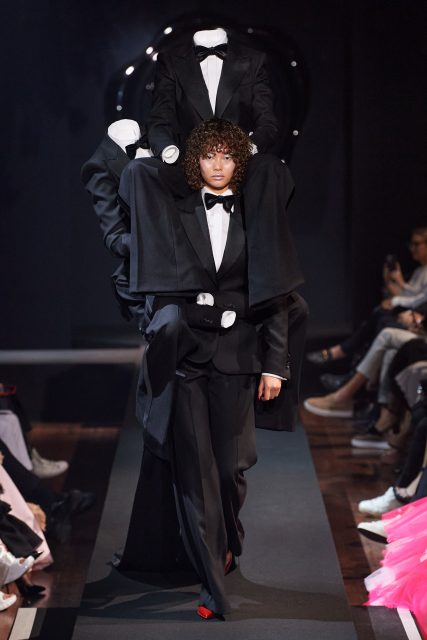The guest designer gigs at the house of Jean Paul Gaultier have become a delight of couture week. This time it was the turn of Julien Dossena, whose day job is at Rabanne. His response was full of verve and enthusiasm, shown so close-up we could have touched the clothes. “I wanted a feeling of characters you pass in the street in Paris,” he said. “I wanted to make all of them queens, each with a different crown.”
The honor of being able to bring his interpretation to the work of a national treasure of French haute couture couldn’t have been more sincerely felt. “Jean Paul was the first designer I ever saw on TV when I was very young. Watching him, I understood for the first time: oh, fashion can be a job! What he did (became) infused into my cultural background in general.” Over lunch with his idol, Dossena discovered that Gaultier had known Paco Rabanne, who had recently passed away. “He asked me to make something to honor him. But I had from him this complete sense of freedom. There’s this feeling in the couture ateliers that anything can be done.
At Rabanne, Dossena’s ability to modernize chainmail and turn it into new techniques in zillions of ways has been one of the hallmarks of his talent—that, and the slant on bohemian glamour that frequently comes through his collections. His unmistakable double-salute to Gaultier and Rabanne was to whip up a replica of the famous pointy-bra dress from Gaultier’s first collection in 1984 in silver chainmail.
But the dimension of Gaultier’s work which sparked Dossena’s imagination the most was his street-observation and inclusiveness—decades before it became fashionable. “Jean Paul was really the first to treat fashion as almost sociology, watching what people wear in the street, expressing communities in his shows. Joyously mixing people together.”
Dossena was re-making his richly eclectic point in a week when the social and racial divisions in Paris have again broken out into rioting. His own symbol of equality-in-diversity amongst his ‘characters’ of Paris was crowning them with diadems and jewelled circlets “as if they’d found them on the market.” Some of them were wearing haute couture versions of laurel wreaths—also seen around Paris. “You know, you go around and see these neo-classical statues everywhere. I thought, why not put them on girls in the street?”
Dossena’s presentation of chic-ified looks included a pinstriped trouser suit and a lace dress over a pair of trompe l’oeil beaded jeans with sweeping trains. Mid-way, in a stunning moment that spoke dramatically to the beauty of human togetherness, he draped shining gold and silver swathes of chainmail to connect pairs of models—a man apparently carrying a woman’s train, and two individualistic goddess warriors, each symbolizing a different culture.
He drew from some of Gaultier’s greatest hits, of course—it’s part of the job in this one-off role. There were references to Gaultier’s giant trapper hat, to the sweeping floor length coats in his “Rabbi Chic” collection, and to off-the shoulder lace he used in his “La Concierge est Dans l’Escalier” show. Dossena said he’d deeply related to Gaultier’s habit of trawling flea-markets for vintage finds—a route into developing rich techniques. Part-way, there was a dress made of Irish-crochet lace, embroidered with gold paillettes meticulously made to look vintage. There was a peach satin lingerie dress layered over black lace, a floral lace apron worn over tailoring.
And just as you thought Dossena might have missed a little something of the subversive wit that got Gaultier permanently labeled the Enfant Terrible of French fashion, sure enough, there it was. Clearly glimpsed through a couple of sheer dresses, a pair of trompe l’oeil embroideries of pubic hair. Sitting in the front row, Jean Paul Gaultier raised his eyebrows and chuckled as they passed by.
Read Next
Viktor & Rolf Reconstructs Bathing Suits With A Surrealist Couture Twist
Editor
Sarah MowerCredit
Lead Image: Daniele Oberrauch / Gorunway.com

